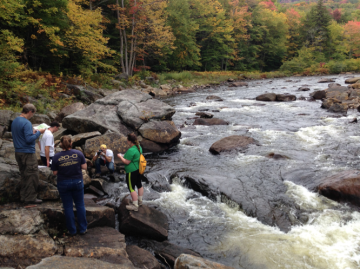
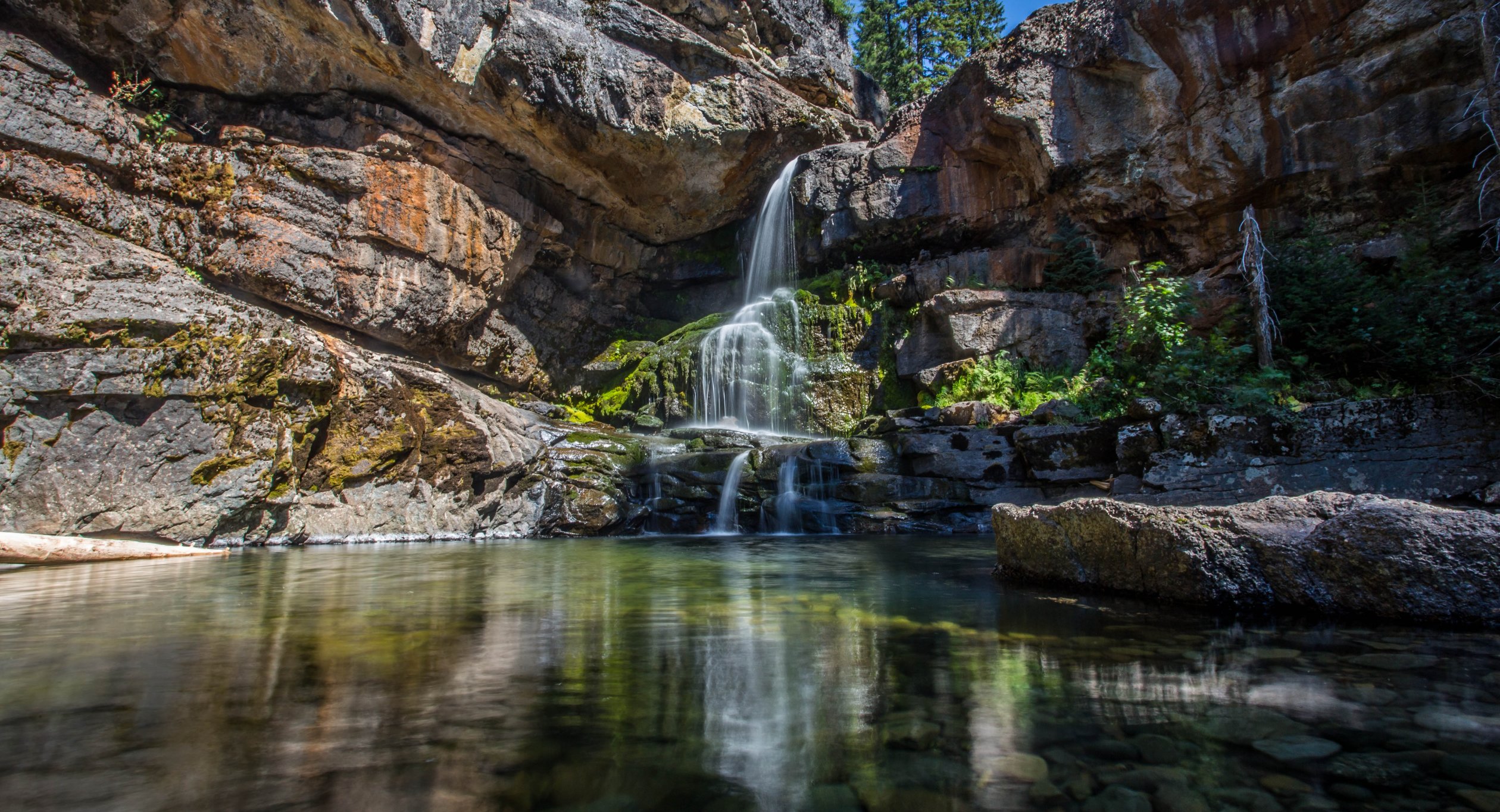
Geology Department
What We Do
The mission of the Department of Geology is to provide knowledge and understanding of the earth and its hazards and resources as well as an understanding of the interactions of the earth with other natural environments and with society to students in Geoscience, the other natural sciences, liberal arts, and pre-professional programs who choose such courses as part of their majors, minors and general education electives.
Office Location
176 Gordon Science Center
Utica Geoscience on Facebook Utica Geoscience on Instagram
Geoscience is a broad, interdisciplinary field comprising geology as well as aspects of ocean science, atmospheric science, planetary science, and environmental science. Utica University offers both B.S. and B.A. degrees in Geoscience.
The B.S. affords greater depth in geoscience and the other physical sciences and is designed to prepare students to work in applied earth and environmental science or pursue graduate studies in geoscience or related disciplines.
Those interested in a program in earth and environmental science designed to provide substantial breadth in science preparation by also including coursework in biology, environmental issues, and astronomy may elect to pursue the B.A. Each degree is also appropriate for teaching secondary earth science.
Students interested in teaching should see also the Undergraduate and Master's Programs in Education.
Geoscience Bachelor of Science
The bachelor of science option is designed to prepare students to work in applied earth and environmental science or pursue graduate studies in geoscience or related disciplines. A capstone experience such as a field course, directed research, or internship will be required of students receiving the B.S. to integrate liberal and professional study.
Students who complete the BS degree will:
- Explain the fundamentals of the Theory of Plate Tectonics, including its causes and its effects, and the evidence that supports its occurrence;
- Describe aspects of Plate Tectonic Theory about which there is uncertainty and/or disagreement;
- Explain and provide illustrative examples of how earth processes and materials impact human society and how activities of human society impact the earth and environment; describe and explain in detail several examples of each with emphasis on interactions with the geology in addition to the broader environment;
- Explain the limitations of several different methods used to perform historical science, and justify how and why multiple approaches are used simultaneously;
- Explain how modern-day processes can be used to reconstruct the processes and events of Earths’ deep past and its evolution over periods of time
BACHELOR OF SCIENCE ACADEMIC REQUIREMENTS
Geoscience Bachelor of Arts
The bachelor of arts option is designed to provide substantial breadth in science preparation by also including coursework in biology, environmental issues, and astronomy, allowing students greater flexibility in tailoring the degree to meet their needs and interests.
Students who complete the BA degree will:
- Explain the fundamentals of the Theory of Plate Tectonics, including its causes and its effects, and the evidence that supports its occurrence;
- Explain and provide illustrative examples of how earth processes and materials impact human society and how activities of human society impact the earth and environment; describe and explain in detail several examples of each with emphasis on interactions with the broader environment in addition to the geology;
- Explain the limitations of several different methods used to perform historical science, and justify how and why multiple approaches are used simultaneously;
- Explain how modern-day processes can be used to reconstruct the processes and events of Earths’ deep past and its evolution over periods of time.
BACHELOR OF ARTS ACADEMIC REQUIREMENTS
Academic Minor
Utica University also offers an Academic Minor in Geoscience.
A competence in geology and the other earth sciences may enhance the career possibilities of primary and secondary school teachers and individuals pursuing graduate opportunities or employment in other science fields, such as chemistry, biology and physics. The Geoscience Minor is also appropriate for majors in economics, politics, anthropology/sociology who anticipate careers in government or industry that will involve issues of public policy concerning the environment.

As part of the Bachelor of Science in Geology at Utica University, students complete a capstone project that may be an independent research, an internship, or completion of field camp, although some students elect to do more than one project.
Most students in our program elect to conduct independent research that typically occurs in their senior year, although some have started in their junior year and worked on more than one project. Research is generally related to work that our professors are actively engaged in but we can accommodate a student who has a particular interest. These projects typically culminate with presentations at professional meetings. This allows student to begin building their CV’s for future graduate studies or entry to a professional field. Such projects allow students to show potential employers and graduate schools that they have mastered the skills needed to complete an independent project and have the discipline required to bring about its completion.
Research areas of the faculty at Utica University include climates studies using the sediment record of Adirondack Lakes, mountain building and structural geology in the Maine Appalachians, the Coast Ranges of the Pacific Northwest, Adirondack Mountains, as well as local studies of Central New York geology.
Utica University Student Research
Utica University Student Research Papers at Professional Journals
(Student authors shown in bold.)
Robinson, S. and S.L. Kanfoush, 2017. Potential influence of lake morphometry on paleoproductivity patterns in lakes under similar climate change conditions in the Adirondack Mountains of New York. Northeastern Geographer vol. 9, pp. 29-44.
Utica College Student Research Presentations at Professional Conferences
(Student authors shown in bold.)
Bunyon, E.Q. and A.D. Schoonmaker, 2019. Geochemical study of likely Cambrian or Ordovician age rocks of the Avery Brook Formation and an unnamed tonalite near Caucomoc Lake, northern Maine. Geological Society of America Abstracts with Programs. Vol. 51, No. 1.
DePasquale, B.M., Kozenjic , N. and A. Schoonmaker, 2017, Intrusive rocks of the Game Lake area and implications for the origin of the Snowcamp ophiolite. Geological Society of America Abstracts with Programs. Vol. 49, No. 2.
Kozenjic , N., DePasquale, B.M. and A. Schoonmaker, 2017, Amphibolite of the Game Lake regionand its relation to the Josephine and Coast Range ophiolite. Geological Society of America Abstracts with Programs. Vol. 49, No. 2.
Smith, D. and A. Schoonmaker, 2014. Geochemical and petrological comparison of two mafic dikes with other known Proterozoic and Mesozoic rift dikes and volcanics from the Adirondacks and northern Vermont. Geological Society of America Abstracts with Programs. Vol. 46, No. 2. P. 52.
Robinson, S. Kanfoush, S.L., and A.J. Spado, 2013. Potential influence of lake morphometry on paleoproductivity patterns in lakes under similar climate change conditions in the Adirondack Mountains of New York. Geological Society of America Abstracts w/ Programs 45(7): 0.
Plows, D.R. and A. Schoonmaker, 2013. Petrography, field relations, and geochemical analysis of Ordovician metamorphosed mafic igneous rocks of the Caucomgomoc Lake Inlier, northern Maine. Geological Society of America Abstracts with Programs vol. 45, no. 1: p. 59. Northeast Regional Meeting, Bretton Woods, NH.
Foote, K. and S.L. Kanfoush, 2012. Preliminary examination of valve size of Fragillariopsis kerguelensis as a potential indicator of nutrient content of the Southern Ocean across the glacial termination. Geological Society of America Abstracts with Programs vol. 44, no. 2, p. 49. Northeast Regional Joint Meeting, Hartford, CT.
Bichrest, T. and A. Schoonmaker, 2011. A structural transect of the Seboomook Formation, Caucomogomoc Lake, northwestern Maine. Geological Society of America Abstracts with Programs vol. 43, no. 1, p. 148. Northeast and North-Central Regional Joint Meeting, Pittsburgh, PA.
McGivern, T. and A. Schoonmaker, 2011. Ongoing testing of groundwater and surface water chemistry in the vicinity of the Ross #1 natural gas well, Maryland, New York. Geological Society of America Abstracts with Programs vol. 43, no. 1: p. 105. Northeast and North-Central Regional Joint Meeting, Pittsburgh, PA.
Roose, S. and S.L. Kanfoush, 2011. Record of the 1918/1919 El Nino and long-duration phase of the North Atlantic Oscillation in an Adirondack Lake. Geological Society of America Abstracts with Programs vol. 43, no. 1, p. 70. Northeast and North-Central Regional Joint Meeting, Pittsburgh, PA.
Roose, S. and S.L. Kanfoush, 2010. Potential impacts of interannual to mutidecadal climate oscillations on an Adirondack Lake. Lake, Stream, and Watershed Issues Conference, Sponsored by the Central New York Regional Planning and Development Board, Hosted by Hamilton College, Clinton, NY.
McGivern, T. and A. Schoonmaker, 2010. Characterization of surface and groundwater chemistry before and after gas drilling and hydro-fracturing, Town of Maryland, Otsego County, New York. Geological Society of America Abstracts with Programs vol. 42, no. 1: p. 122. Northeast and Southeast Regional Joint Meeting, Baltimore, MD.
Whittemore, A., Kanfoush, S.L., Provost, T. and C. Pullium, 2006. Examination of polychlorinated biphenyl affinity with sediment grain size and organic matter. American Chemical Society Abstracts with Programs, Northeast Regional Meeting, Binghamton, NY.
Kanfoush, S.L.and M.W. Washburn, 2006. Preliminary study of morphology of ice-rafted debris in the southeast Atlantic across Termination V. Geological Society of America Abstracts with Programs vol. 38, no. 2: p. 14. Regional Meeting, Harrisburg, PA.
Hyer, E.A., Lounsbury, J.A., Kanfoush, S.L., Provost, T.L. and C.R. Pulliam, 2006. Downcore occurrence of polychlorinated biphenyls in the Utica Marsh, central New York. American Chemical Society Abstracts with Programs, Northeast Regional Meeting, Binghamton, NY.
Lounsbury, J.A., Hyer, E.A., Kanfoush, S.L., Provost, T.L. and C.R. Pulliam, 2006. Downcore occurrence of polychlorinated biphenyls in the Utica Marsh, central New York. Geological Society of America Abstracts with Programs vol. 38, no. 2: p. 80. Regional Meeting, Harrisburg, PA.
Chapman, G.E., Kanfoush, S.L. and E. Domack, 2004. Fine sediment in ODP Site 1094 (South Atlantic): Eolian versus hemipelagic determination. Geological Society of America Abstracts with Programs 36 (2): 154. Regional Meeting, Washington, D.C.
Comprehensive List of Utica College Student Research Projects
2018
Erica Hulbert – Comparison of Morphological Variation in Fragillariopsis kerguelensis in South Atlantic Sediments in Response to Deglaciation Across the Polar frontal Zone
2017
Brittany M. DePasquale & Nuredin Kozenjic – Intrusive Rocks of the Game Lake Area and Implications for the Origin of the Snowcamp Ophiolite
Nuredin Kozenjic & Brittany M. DePasquale – Amphibolite of the Game Lake regionand its relation to the Josephine and Coast Range Ophiolite
2014
Max Darman - Preliminary Examination of Sediment Characteristics of Recent Flood Events of the Mohawk River, New York to Assess Potential for Paleoflooding Reconstruction
Dwayne Smith – Geochemical and Petrographic Comparison of Two Adirondack Mafic Dikes with Other Known
Proterozoic and Mesozoic Rift Dikes and Volcanics from the Adirondacks and Northern Vermont
2013
Sarah Robinson – Influence of Lake Morphometry on Paleoproductivity Patterns in Lakes Under Similar Climate Change Conditions in the Adirondack Mountains
James Lee - Using Geophysical Methods to Determine the Southern Extent of the Dolgeville Fault in central New York
Dan Plows - Petrography, Field Relations, and Geochemical Analysis of Ordovician Metamorphosed Mafic Igneous Rocks of the Caucomgomoc Lake Inlier, northern Maine
2012
Kimberly Foote – Morphological Variation in Fragillariopsis kerguelensis in South Atlantic Sediments in Response to Deglaciation
Katrina Burnett - Examination of Geographic and Socioeconomic Patterns in Opinions About Hydrofracking for Natural Gas in Central and Southern New York.
2011
Tiffany Bichrest – A Structural Transect in the Devonian Seboomook Formation of Maine
Miriam Bernstein – Potential Impact of Calcium Content of Drinking Water Sources on Osteoporosis Incidence
Dan Plows – Radiometric Dating to Determine Changing Sedimentation Rates in an Adirondack Lake
2010
Tiffany McGivern – Characterization of Surface and Groundwater Chemistry Before and After Gas Drilling and Hydro-Fracturing, Town of Maryland, Otsego County, New York
Spencer Roose – Record of the 1918/1919 El Nino and a Long-Duration Positive Phase of the North Atlantic Oscillation within an Adirondack Lake.
Kristen Hamner - Magnetic Susceptibility and Loss-on-Ignition Analysis of Adirondack Lake Sediments
2009
Keriann Thuener – Dikes of the Adirondack Region: A Mafic Dike at Golden Stair Creek
Yvette Abounader – Estimation of the Annual Carbon Footprint of Utica College
2008
Greg Hurd (a visiting Wesleyen University student intern) – High-Resolution Multiproxy Analysis of Adirondack Lake Sediments to Constrain the Timing and Frequency of Multiannual- to Decadal-Scale Variations and Identify Potential Causes
Tessa Malcarne – Environmental Audit of Utica College
2007
Adriane Spytko – Morphological Variations in Stephanodiscus niagarae in Lake Erie Sediments in Response to Historical Nutrient Loading
2006
Amanda Whittemore – Examination of Sediment Grain Size and Organic Content in Marsh Sediments and Implications for Polychlorinated Biphenyl Affinity and Distribution.
2005
Michael Washburn – Morphology of Ice-Rafted Debris in the Southeast Atlantic Across Glacial Termination V.
Jennifer Lounsbury and Elizabeth Hyer – Occurrence of Polychlorinated Biphenyls in the Utica Marsh, New York.
2004
Gillian Chapman – Grain Size Analysis of Fine Sediments at Site 1094 (South Atlantic): Eolian vs. Hemipelagic Origin.
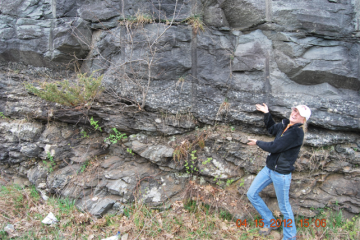
Geology classes at Utica University are strongly infused with field experiences in the form of field trips during laboratories, or as larger weekend trips to Vermont and the Adirondacks. Also, our field experience to Oregon and New England is a multi-week trip during the summer.
Field trips give students the opportunity to examine and learn to recognize rocks, landscapes, and surficial features related to mountain-building, mineralogical, hydrologic (streams, lakes, groundwater), glacial, and weathering processes.
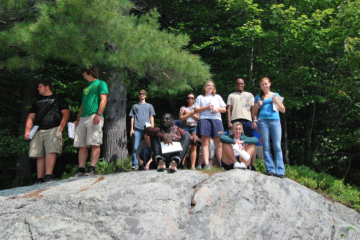
The department offers a field camp experience in Oregon, Washington State, and northern California, or in New England. In the Pacific Northwest, students visit a variety of volcanoes and learn about volcanic and plate tectonic processes first hand. This is a multi-week trip that combines camping, mountain-climbing (non-technical), sample collection, and geologic mapping in a spectacular landscape. We also visit the California and Oregon Coast to see coastal processes first-hand along with the Redwoods!
Students may also elect to combine their field camp experience with an independent research project in the Big Craggies (Kalmiopsis Wilderness Area) of southwest Oregon.
The New England field camp combines a wide variety of experiences for students including a dinosaur trackway, examination of mountain-building processes in the northern Appalachians, coastal Maine excursions, field mapping, and trips to the North Maine Woods and Adirondack Mountains as well as field stops in the New Hampshire White Mountains and the Green Mountains of Vermont.
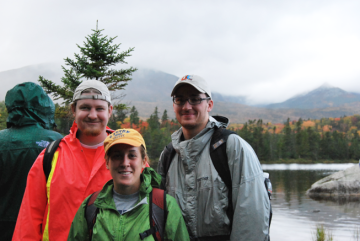
Utica University Geoscience majors gain hands-on learning experiences through internships at places such as Skidaway Institute of Oceanography in Savannah, Georgia as well as in the private sector such as performing groundwater monitoring with a private geoscience company.
Some of our students have been selected to serve as interns at the Rogers Environmental Education Center in Sherburne, NY. The positions are summer paid positions and housing is provided by the Rogers Center. Interns typically facilitate environmental education programs for children, but also assist with mixed adult and kids programs such as canoe and kayak trips. They also have the opportunity to develop their own environmental education programs to be implemented at the center.
The Utica University campus offers excellent facilities and resources for the study of geoscience.
In Summer 2020, Utica University broke ground on a new, $12-14 million science center - the latest in a string of campus improvements designed to support growing academic areas and improve the quality of student life. The Science Center contains new, state-of-the-art laboratories and classrooms for Utica University science classes.The 22,000-25,000 square-foot building connects to the Gordon Science Center and Romano Hall (the health sciences building).
Recent NASA and NSF grants have supported the installation of additional advanced technology and instrumentation within numerous facilities on campus.
The proximity of Utica University to the Adirondack and Catskill Mountains, Mohawk Valley, Utica Marsh, and Great Lakes and Finger Lakes makes its geographic location ideal to provide ample learning opportunities vital to advanced learning in geoscience.
Housed in Utica's Gordon Science Center, the Geology Department equipment includes:
- Geometrics ES-3000 18-geophone seismograph
- Worden Gravimeter
- Geometrics G857 Magnetometer
- Fluid inclusion analysis microscope with heating and freezing units
- equipment for sedimentological analysis, including sieves, a Ro-Tap shaker, and hydrometers
- multiple current meters
- stereo microscopes and a differential interference contrast microscope for microfossil analysis
- rock cutting and thin-sectioning equipment and microscopes for petrographic analysis
- a collection of local- to continental-scale topographic and geologic maps and aerial photographs for structural geologic studies
The Department maintains extensive fossil and mineral collections that include numerous specimens from the local area and the Adirondack Mountains.
A $1.7 million grant from NASA to UC was used to update and expand the college's science teaching and research resources. From this the geology department added instrumentation to support coursework and faculty and student research in paleolimnology, paleoceanography and paleoclimatology; including:
- sediment coring equipment and a small inflatable raft for lake and wetland sampling and monitoring
- a YSI in-situ multisensor water quality probe
- an integrated suspended sediment sampler and bottom sediment grab sampler
- a Malvern automated sediment grain size analyzer
- Bartington whole-core and discrete-sample magnetic susceptibility meter
- Ortec gamma detection system for radiometric dating of sediment cores, and
- ArcGIS geographic information systems (GIS) software.
A grant from the National Science Foundation to a Geology Department faculty member enabled purchase of a large-format plotter. And, reflecting the University's commitment to providing opportunities to work hands-on with modern technology, Utica recently provided the Geology Department funds to purchase new geophysical equipment, including instrumentation for seismic profiling.
Contact Us
Sharon Kanfoush
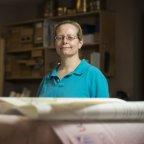
Sharon Kanfoush
Geology Department Chair
(315) 792-3134
Faculty
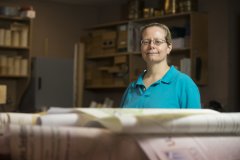
- Distinguished Professor of Geology
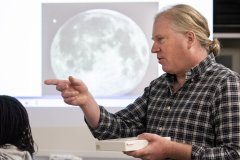
- Professor of Geology
- Adjunct Lecturer of Geology
- Adjunct Lecturer of Geology
- Adjunct Lecturer of Geology
I would like to see logins and resources for:
For a general list of frequently used logins, you can also visit our logins page.
